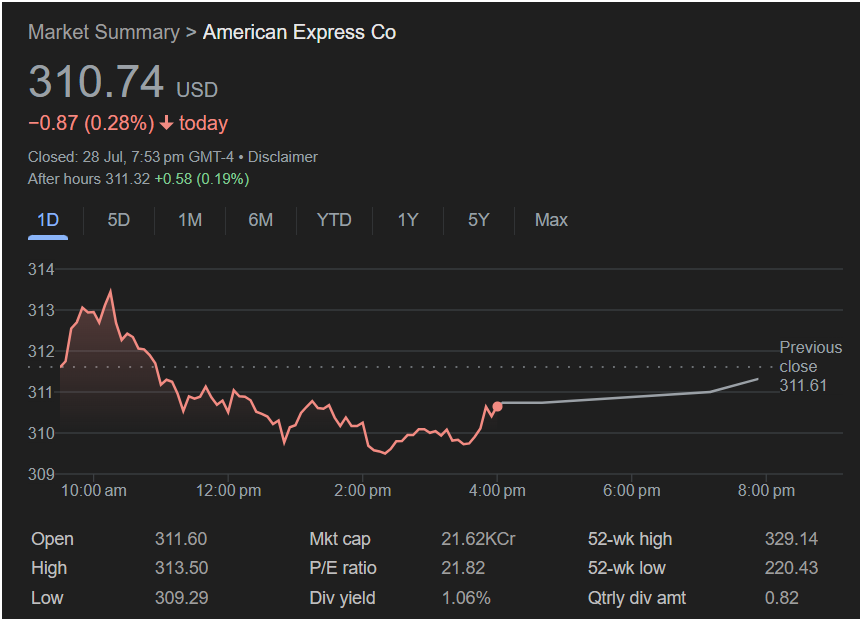American Express (AXP) Stock Falters in Volatile Session, But After-Hours Action Sparks Investor Debate

NEW YORK – American Express Co. (NYSE: AXP) shares finished a turbulent trading day in the red, reflecting broader investor anxieties about the economic landscape and its impact on consumer spending. The stock closed at $310.74, marking a decline of $0.87, or 0.28%, for the session. However, a modest uptick in after-hours trading has left market participants parsing signals, questioning whether the dip represents a transient wobble or the beginning of a more significant trend for the financial services giant.
The day’s trading for AXP was a classic tale of early optimism followed by sustained pressure. The stock opened at $311.60, just shy of the previous day’s close of
313.50**. This early strength quickly dissipated as the market digested a complex mix of economic data and sentiment, sending the stock on a steady downward trajectory. It eventually hit an intraday low of $309.29 in the afternoon before a late-day rally helped it claw back some losses, though not enough to push it into positive territory by the closing bell. This volatility underscores the current tug-of-war between bulls who champion the resilience of Amex’s premium consumer base and bears who fear the impact of a potential economic slowdown.
From a valuation perspective, American Express presents a mixed but compelling picture. With the day’s close, the stock is trading significantly below its 52-week high of
220.43, placing it in the upper-middle range of its annual performance. The company’s price-to-earnings (P/E) ratio stands at a solid 21.82, a metric investors will scrutinize against industry peers and its own historical levels to gauge its current valuation. For income-focused investors, the dividend yield of 1.06%, supported by a quarterly dividend of $0.82 per share, offers a modest but steady return. As a heavyweight in the global financial system with a market capitalization in the vicinity of $165 billion, its performance serves as a key indicator of economic health.
No stock trades in a vacuum, and American Express is particularly sensitive to the broader economic climate. As a bellwether for high-end consumer spending, the company’s fortunes are intrinsically linked to factors like consumer confidence, inflation, and interest rate policies. Persistently high inflation can erode purchasing power, while rising interest rates, designed to cool the economy, can increase borrowing costs and heighten the risk of a recession. Investors are closely watching data related to travel, dining, and luxury goods—core components of the Amex business model. Any sign of a slowdown in these areas could put pressure on AXP’s revenue growth, a concern that likely contributed to the day’s bearish sentiment.
Despite the market’s skittishness, the bull case for American Express hinges on its unique market position. The company caters to a more affluent clientele, who are often better insulated from economic downturns than the average consumer. This premium customer base has historically demonstrated remarkable spending resilience. Furthermore, the ongoing recovery and normalization of global travel and entertainment continue to be a powerful tailwind for the company. Wall Street analysts remain broadly constructive on American Express, with many pointing to its strong brand and loyal customer base, but near-term price targets often reflect the prevailing macroeconomic uncertainty.
Adding an intriguing wrinkle to the narrative is the after-hours activity. After closing at
311.32**, a gain of 0.19%. While trading volumes in extended sessions are thin and not always indicative of the next day’s direction, this slight recovery could suggest that some investors viewed the intraday sell-off as overdone, stepping in to buy what they perceived as a discounted price.
As investors digest the day’s volatile price action, the focus now shifts to the path ahead. The push and pull between American Express’s robust business model and the challenging macroeconomic environment are set to continue defining its stock performance. Key questions loom large: Can the strength of the premium consumer continue to defy gravity in the face of economic headwinds? And how will the company navigate the complex landscape of inflation and interest rates? The answers will likely unfold in upcoming economic reports and the company’s own future guidance, leaving the market to watch with bated breath.

